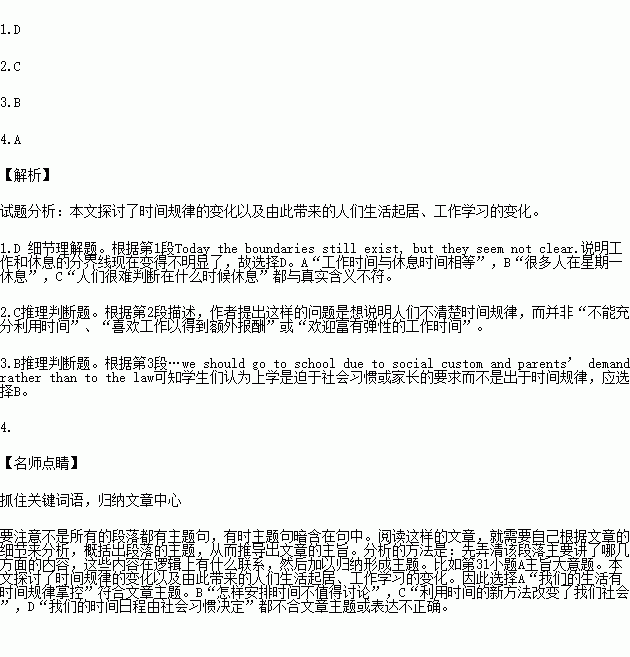题目内容
Sunday is more like Monday than it used to be. Places of business that used to keep daytime“business hours” are now open late into the night. And on the Internet, the hour of the day and the day of the week have become irrelevant(不相关的). A half century ago in the United States, most people experienced strong and precise dividing lines between days of rest and days of work, school time and summer time. Today the boundaries still exist, but they seem not clear.
The law in almost all states used to require stores to close on Sunday; in most, it no longer does. It used to keep the schools open in all seasons except summer; in most, it still does. And whether the work week should strengthen its legal limits, or whether it should become more “flexible,” is often debated. How should we, as a society, organize our time? Should we go even further in relaxing the boundaries of time until we live in a world in which every minute is much like every other?
These are not easy questions even to ask. Part of the difficulty is that we rarely recognize the “law of time” even when we meet it face to face. We know as children that we have to attend school a certain number of hours, a certain number of days, a certain number of years — but unless we meet the truant officer (学监), we may well think that we should go to school due to social custom and parents’ demand rather than to the law. As adults we are familiar with “extra pay for overtime working,” but less familiar with the fact that what constitutes(构成)“overtime” is a matter of legal definition. When we turn the clock forward to start daylight-saving time, have we ever thought to ourselves: “Here is the law in action”? As we shall see, there is a lot of law that has great influence on how we organize and use time: compulsory education law, overtime law, and daylight-saving law — as well as law about Sunday closing, holidays, being late to work, time zones, and so on. Once we begin to look for it, we will have no trouble finding a law of time to examine and assess.
1. By saying “Sunday is more like Monday than it used to be”, the writer means that_______.
A. work time is equal to rest times
B. many people have a day off on Mondays
C. it is hard for people to decide when to rest
D. the line between work time and rest time is unclear
2. The author raises the questions in Paragraph 2 to introduce the fact that people __________.
A. fail to make full use of their time
B. enjoy working overtime for extra pay
C. are unaware of the law of time
D. welcome flexible working hours
3.According to the passage, most children tend to believe that they go to school because they ______.
A. need to acquire knowledge B. have to obey their parents
C. need to find companions D. have to observe the law
31. What is the main idea of the passage?
A. Our life is governed by the law of time.
B. How to organize time is not worth debating.
C. New ways of using time change our society.
D. Our time schedule is decided by social customs.
 天天向上一本好卷系列答案
天天向上一本好卷系列答案 小学生10分钟应用题系列答案
小学生10分钟应用题系列答案
